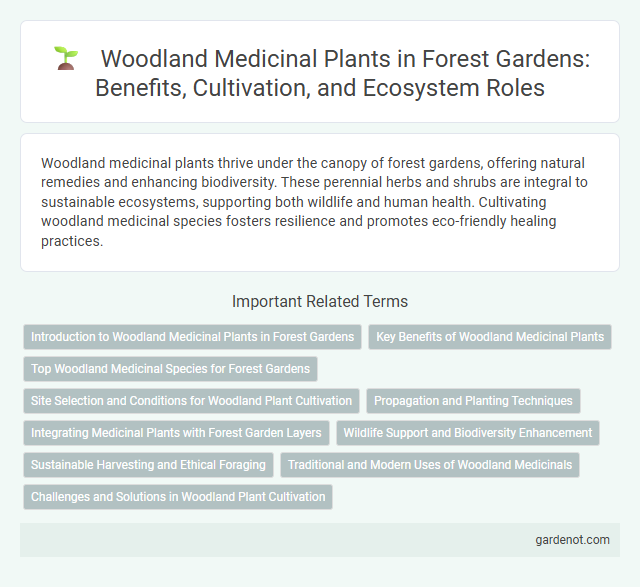Woodland medicinal plants thrive under the canopy of forest gardens, offering natural remedies and enhancing biodiversity. These perennial herbs and shrubs are integral to sustainable ecosystems, supporting both wildlife and human health. Cultivating woodland medicinal species fosters resilience and promotes eco-friendly healing practices.
Introduction to Woodland Medicinal Plants in Forest Gardens
Woodland medicinal plants in forest gardens offer a sustainable source of herbal remedies that thrive under the canopy's shade and rich soil conditions. Species such as goldenseal, bloodroot, and ginseng are commonly cultivated for their therapeutic properties, supporting biodiversity and traditional medicine practices. These plants contribute to ecosystem health by promoting soil fertility and providing habitat for beneficial insects.
Key Benefits of Woodland Medicinal Plants
Woodland medicinal plants offer significant therapeutic properties, including anti-inflammatory, antimicrobial, and antioxidant effects that support overall health and immune function. These plants contribute to natural pain relief, wound healing, and respiratory health, making them valuable in traditional and modern herbal medicine. Their integration into forest gardens promotes biodiversity while providing sustainable sources of natural remedies.
Top Woodland Medicinal Species for Forest Gardens
Top woodland medicinal species for forest gardens include Echinacea purpurea, known for boosting the immune system and treating colds, and Goldenseal (Hydrastis canadensis), valued for its antimicrobial properties. Ginseng (Panax quinquefolius) thrives in shaded forest environments and supports energy and stress relief. Other key species are Black Cohosh (Actaea racemosa) for hormone balance and Witch Hazel (Hamamelis virginiana) for its skin-healing benefits, making them essential components for diversified, functional forest gardens.
Site Selection and Conditions for Woodland Plant Cultivation
Woodland medicinal plants thrive in shaded, fertile soils rich in organic matter with well-draining properties to prevent root rot. Optimal site selection includes areas with partial to full canopy cover providing dappled sunlight and consistent moisture levels for understory growth. The microclimate should maintain humidity and temperature ranges conducive to native woodland species, avoiding exposure to harsh winds or waterlogged conditions.
Propagation and Planting Techniques
Woodland medicinal plants propagate effectively through layering, division, and seed sowing, promoting genetic diversity and resilience. Optimal planting techniques include selecting shaded, moist soil conditions that mimic natural forest understory environments, enhancing root establishment and growth. Incorporating mulch and companion planting further improves soil health and protects young medicinal plants from pests and diseases.
Integrating Medicinal Plants with Forest Garden Layers
Integrating medicinal plants within forest garden layers enhances biodiversity and promotes sustainable herbal harvesting. Shade-tolerant species like goldenseal and ginseng thrive under the forest canopy, while dynamic accumulators such as comfrey enrich the soil in shrub and herbaceous layers. Utilizing vertical space with climbing medicinal vines like valerian maximizes yield and supports holistic ecosystem health.
Wildlife Support and Biodiversity Enhancement
Woodland medicinal plants play a crucial role in forest gardens by supporting diverse wildlife populations, including pollinators, birds, and beneficial insects. These native species enhance biodiversity by creating varied habitats and food sources, promoting ecosystem resilience. Integrating medicinal flora boosts habitat complexity, which is essential for sustaining healthy forest garden environments.
Sustainable Harvesting and Ethical Foraging
Sustainable harvesting in woodland medicinal plants involves carefully selecting only mature specimens to allow natural regeneration and maintain biodiversity. Ethical foraging practices prioritize minimal disturbance to the ecosystem, avoiding overharvesting and respecting local regulations. Employing techniques such as rotational harvesting and habitat conservation supports long-term availability of medicinal resources in forest gardens.
Traditional and Modern Uses of Woodland Medicinals
Woodland medicinal plants have been used for centuries in traditional healing practices, utilizing species like goldenseal, echinacea, and nettle for their antimicrobial, anti-inflammatory, and immune-boosting properties. Modern uses expand on this foundation through clinical research that validates their efficacy in treating respiratory infections, skin conditions, and digestive issues, integrating these botanicals into herbal supplements and natural remedies. Conservation of native woodland species ensures sustainable harvesting that supports both ecological health and medicinal availability.
Challenges and Solutions in Woodland Plant Cultivation
Woodland medicinal plant cultivation faces challenges such as limited sunlight, competition for nutrients, and susceptibility to pests and diseases. Implementing adaptive pruning techniques, selecting shade-tolerant species, and using organic pest control methods enhance growth and resilience. Soil enrichment through compost and mycorrhizal inoculation addresses nutrient competition, promoting sustainable woodland medicinal gardens.
Woodland medicinal Infographic

 gardenot.com
gardenot.com